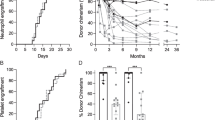Abstract
A boy whose chronic granulomatous disease (CGD) manifested in infancy, and whose elder brother had died at 7 years of age, had phagocytes with complete lack of functional cytochrome B-245 and which could not be induced by interferon gamma to achieve adequate staphylococcal killing. He underwent an elective displacement bone marrow transplant from a volunteer unrelated donor at the age of 8 months. This has achieved 100% replacement of the CGD granulocytes by those of the normal volunteer and the boy has since had a normal childhood for 3 years. Six previous transplants for CGD are briefly reviewed and illustrate that the host abnormal marrow must be completely displaced using an adequate dose of busulphan to ensure 100% stable engraftment of the donor's marrow and that this is best done under elective conditions before septic foci and irreversible organ damage have occurred. Criteria need to be developed to identify early those patients likely to have severe morbidity.
Similar content being viewed by others
Abbreviations
- BMT:
-
bone marrow transplant
- CGD:
-
chronic granulomatous disease
- GVHD:
-
graft-versus-host disease
- NBT:
-
nitroblue tetrazolium
- rHuIFNg:
-
recombinant human interferon-gamma
- VUD:
-
volunteer unrelated donor
References
Berendes H, Bridges RA, Good RA (1957) A fatal granulomatosis of childhood. The clinical study of a new syndrome. Minn Med 40:309–312
Curnutte JT (1988) Classification of chronic granulomatous disease. Hematol Oncol Clin N Am 2:241–252
Di Bartolomeo P, Di Girolamo G Angrilli F, Schettini F, DeMattia D, Manzionna MM, Dragani A, Iacone A, Torlontano G (1989) Reconstitution of normal neutrophil function in chronic granulomatous disease by bone marrow transplantation. BMT 4:695–700
Dinauer MC, Orkin SH (1988) Chronic granulomatous disease — molecular genetics. Hematl Oncol Clin N Am 2:225–240
Ezekowitz RA, Dinauer MC, Jaffe HS, Orkin SH, Newburger RE (1988) Partial correction of the phagocyte defect in patients with X-linked chronic granulomatous disease by subcutaneous interferon gamma. N Engl J Med 319:146–151
Finn A, Hadzic N, Morgan G, Strobel S, Levinsky RJ (1990) Prognosis of chronic granulomatous disease. Arch Dis Child 65:942–945
Foroozanfar N, Hobbs JR, Hugh-Jones K, Humble JG, James DCO, Selwyn S, Watson JG, Yamamura M (1977) Bone marrow transplantation from an unrelated donor for chronic granulomatous disease. Lancet I:210–213
Forrest CB, Forehand JR, Axtell RA, Roberts RL, Johnston RN (1988) Clinical features and current management of chronic granulomatous disease. Hematol Oncol Clin N Am 2:253–265
Gallin JI, Malech HL (1990) Update on chronic granulomatous diseases of childhood-immunotherapy and potential gene therapy. JAMA 263:1533–1537
Garcia RC, Cross AA, Segal AN (1986) Development of cytochrome B245 in maturing human macrophages. Biochem J 239:647–651
Goudemand J, Aussens R, Delmas-Marsalet T (1976) Attempt to treat a case of chronic familial granulomatous disease by allogeneic bone marrow transplantation. Arch Fr Pediatr 33:121–126
Hobbs JR (1981) Bone marrow transplantation for inborn errors. Lancet II:735–739
Hobbs JR (1985) Correction of 34 genetic diseases by displacement bone marrow transplantation. Plasma Ther Transfus Technol 6:221–246
Hobbs JR (1989) The use of volunteer unrelated donors. In: Hobbs JR (ed) Correction of certain genetic diseases by transplantation. COGENT, Westminster, pp 147–159
Hobbs JR, Hugh-Jones K, Shaw P, Downie CJC, Williamson S (1986) Engraftment rates related to busulphan and cyclophosphamide dosages for displacement bone marrow transplants in fifty children. BMT 1:201–208
Kamani N, August CS, Campbell DE, Hassan NF, Douglas SD (1988) Marrow transplantation in chronic granulomatous disease: an update with sex year follow-up. J Pediatr 113:697–700
Lehrer RI, Cline MJ (1969) Interaction ofCandida albicans with human leukocytes and serum. J Bacteriol 98:996–1004
Maury CPJ, Enholm E, Teppo A-M (1983) Is interferon an “inducer” of serum amyloid A? N Engl J Med 309:1060
Monteil M, Hobbs JR, Citron K (1987) Selective immunodeficiency affecting staphylococcal response. Lancet II:880–883
Mouy R, Fischer A, Vilmer E, Seger R, Griscelli C (1989) Incidence, severity and prevention of infections in chronic granulomatous disease. J Pediatr 114:555–560
Mouy R, Seger R, Bourquin JP, Veber F, Blanche S, Griscelli C, Fischer A (1991) Interferon gamma for chronic granulomatous disease. N Eng J Med 325:1516
Neijens HJ, Frenkel J, Muinck Keizer-Schrama SMPF de, Dzoljic-Danilovic G, Meradji M, Dongen JM van (1989) InvasiveAspergillus infection in chronic granulomatous disease: treatment with Itraconazole. J Pediatr 115:1016–1019
Rappeport JM, Newburger PE, Goldblum RM, Goldman AS, Nathan DG, Parkman R (1982) Allogeneic transplantation for chronic granulomatous disease. J Pediatr 101:952–955
Sechler JMG, Malech HL, White CJ, Gallin JI (1988) Recombinant human interferon-γ reconstitutes defective phagocyte function in patients with chronic granulomatous disease in childhood. Proc Natl Acad Sci 85:4874–4878
Segal AM (1989) The electron transport chain of the microbicidal oxidase of phagocytic cells and its involvement in the molecular pathology of chronic granulomatous disease. J Clin Invest 83:1785–1793
The International Chronic Granulomatous Disease Cooperative Study Group (1991) A controlled trial of interferon gamma to prevent infection in chronic granulomatous disease. N Engl J Med 324:509–516
Author information
Authors and Affiliations
Rights and permissions
About this article
Cite this article
Hobbs, J.R., Monteil, M., McCluskey, D.R. et al. Chronic granulomatous disease 100% corrected by displacement bone marrow transplantation from a volunteer unrelated donor. Eur J Pediatr 151, 806–810 (1992). https://doi.org/10.1007/BF01957929
Received:
Accepted:
Issue Date:
DOI: https://doi.org/10.1007/BF01957929




